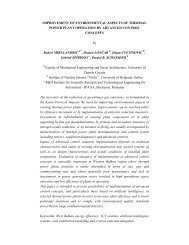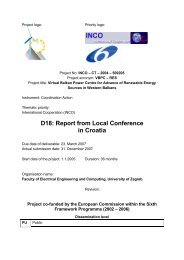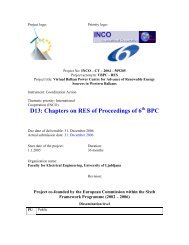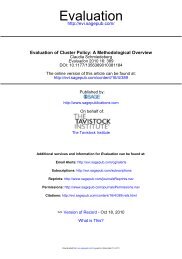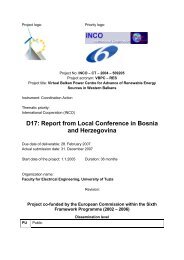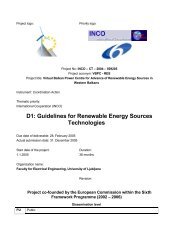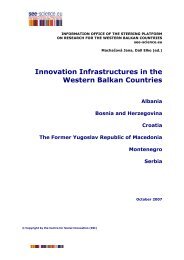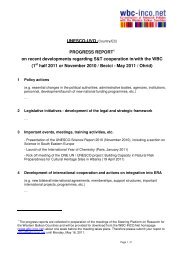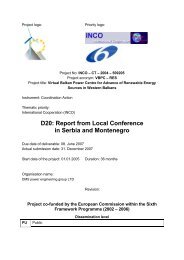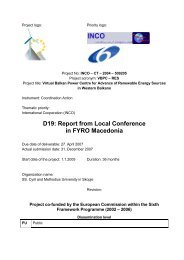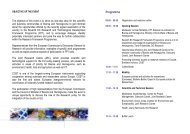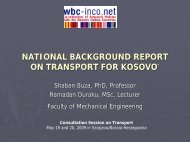National Profile
National Profile
National Profile
Create successful ePaper yourself
Turn your PDF publications into a flip-book with our unique Google optimized e-Paper software.
06<br />
Austria<br />
“Austria achieved outstanding results in<br />
several application areas related to the<br />
Strategic Research Agenda such as highly<br />
developed public transport, waste management<br />
systems, green energy and private spaces.“<br />
AuSTRIA<br />
INTRODucTION<br />
Austria is a relatively small, highly developed and service<br />
oriented economy with a strong industrial sector<br />
that is characterised by high level of innovation and R&D<br />
development. In respect to the IT sector in general and embedded<br />
systems and industrial informatics in particular,<br />
Austria is represented by R&D branches of large multinational<br />
companies such as Siemens and ABB, but the majority<br />
of development is focused by the SMEs that correspond<br />
to roughly 90% of the companies in the country.<br />
Austria achieved outstanding results in several application<br />
areas related to the Strategic Research Agenda such<br />
as highly developed public transport, waste management<br />
systems, green energy and private spaces.<br />
On the government side, the R&D is characterised by the<br />
high level of investment, above the EU average and the<br />
FLExIBLE MANuFAcTuRINg<br />
Austria’s manufacturing sector is an important contributor<br />
to the national economy accounting for 18% of<br />
total GDP. Austrian manufacturing focuses on specialized<br />
high-quality products, mainly in the traditional industries<br />
such as iron and steel making. However high-technology<br />
production is on the rise due to the high spending on research<br />
and innovation in the country (highest in the SEE<br />
region).<br />
Austrian companies typically build hydroelectric or thermal<br />
power stations, chemical plants, steelworks, and<br />
seamless pipelines as well as provide electrical and electronics<br />
equipment. Other important manufactured products<br />
include aluminium, industrial machinery, motor vehicles<br />
(especially industrial and rough-terrain vehicles) and<br />
automotive parts, chemicals, electronic goods and components,<br />
textiles, and such consumer goods as food, glass<br />
and porcelain, and highly prized handmade products.<br />
The corporate structure of the Austrian economy is dominated<br />
by a large number of small and medium-sized<br />
enterprises. More than 95% of all enterprises employ fewer<br />
than 20 employees and only 0.4% of the companies<br />
are large companies with more than 250 employees, in<br />
which more than 40% of all employed work. Austria is<br />
characterised by high labour costs with the hourly rate of<br />
highest in the SEE region. Austria has long lasting experience<br />
in participation in transnational cooperation programs.<br />
On the national level, two government agencies:<br />
FFG (Austrian Research Promotion Agency) and FWF<br />
(Austrian Science Fund) provide national funding mechanisms<br />
and coordinate activities on the international level.<br />
Austria has a crucial position as a well integrated country<br />
in between established business and innovation culture<br />
of Western Europe and intensively developing East Europe<br />
in general and the SEE region in particular. Over the<br />
last 20 years Austrian companies established themselves<br />
in the SEE region in banking, energy, construction and IT<br />
sectors and serve as a integration facilitator of the region<br />
into the EU.<br />
33.20 Euro which is among the highest in the EU (EU-15<br />
average is 28.47 and EU-27 is 24.19).<br />
Austrian economy is characterised of high importance of<br />
industry (it ranks third among leading industrial countries<br />
with 30.7% of GDP). <strong>National</strong> manufacturing has<br />
a high level of investment in R&D with the investment<br />
ratio of 5.7% (investment as a share of revenue). However<br />
the investment ratio depends on a particular industry<br />
with a relatively large variation: 1.9% in the vehicle industry<br />
and 14.1% in the glass industry.<br />
In general Austrian manufacturing is characterised by<br />
the high productivity and labour intensity supported by<br />
excellent educational system especially in technical fields<br />
that provides stable ground for innovation. However the<br />
main challenges for Austria in manufacturing sectors are<br />
the dependence of imported fossil fuel and raw materials<br />
as well as a high labour cost that might threaten the labour<br />
intensive sectors to move their production bases.<br />
Therefore, increasing the energy efficiency of Austrian<br />
manufacturing and integration of automation processes<br />
would considerably reduce production costs and<br />
make Austrian products more competitive on the global<br />
market.<br />
EuROPE gOINg gREEN<br />
Austria’s domestic production of energy is dominated<br />
by hydroelectricity and smaller amounts of other<br />
renewables, mainly biomass. Austria remains an important<br />
importer of energy, in particular fossil fuels, with<br />
most of its remaining energy requirements covered to a<br />
large extent by imports of crude oil from Asian and African<br />
countries, natural gas from Russia and solid fuels<br />
from neighbouring Member States. Austria has a policy<br />
that excludes the use of nuclear energy in its energy mix.<br />
Industry and transport are the most energy consuming<br />
sectors.<br />
Total energy consumption in Austria has increased by<br />
38% since 1990. Transport and industry consume an aggregate<br />
60% of total energy, while households account<br />
for 27% of demand (Figure 2). The shares of each sector<br />
in final energy consumption closely follow that of<br />
the EU-27 average. Demand from the transport sector<br />
has increased dramatically since 1990 (67%). Oil is the<br />
dominant fuel consumed with significant shares of gas<br />
and electricity (Figure 1).<br />
Electricity generation has been increasing over the<br />
past 10 years. Generation is based mainly on renewable<br />
sources (hydro, biomass, and industrial waste), and to a<br />
smaller extent on natural gas and solid fuels (Figure 3).<br />
Renewable sources account for more than four times the<br />
corresponding the EU-27 average percentage. The share<br />
of wind power has been increasing and, in 2005, Austria<br />
was 8th among EU countries in terms of installed wind<br />
capacity with an installed capacity of 818 MW (source:<br />
http://www.ewea.org/).<br />
Although, Austria has one of the highest environmental<br />
standards in the world, there is a potential in further development<br />
in all three directives of Lisbon agenda:<br />
20% of renewable energy sources: diversification of<br />
the national energy profile which is dominated by<br />
large scale hydro power stations by focusing on other<br />
sources such as wind, solar, waste-to-energy and geothermal.<br />
20% reduction of energy consumption: focus on popularisation<br />
of the use of public transport which is already<br />
of highest standards in Austria.<br />
gREEN ENERgY MARKET<br />
At the moment Austria utilized the potential of large<br />
hydro power stations to the maximum. Further<br />
development is economically not efficient or environmentally<br />
damaging. The next step is development of<br />
small hydropower plants that are defined as power stations<br />
with a capacity of up to 10 MW. They have less<br />
environmental impact, but less efficient and as well<br />
as requiring much more efforts to connect to the grid<br />
which creates a large market for the embedded systems<br />
and industrial informatics development necessary<br />
for integration of large grid distributed systems. At<br />
the moment Austria has a total of about 1,900 small<br />
Figure 1: Total energy consumption in Austria by source<br />
29 %<br />
4 %<br />
30 % Transport<br />
30% Industry<br />
27 % Households<br />
13 % Commercials<br />
Figure 2: Energy consumption<br />
in Austria by sector<br />
67%<br />
27 %<br />
67 % Hydro<br />
29 % Fossil fuel<br />
17 % Other<br />
20% increase in energy efficiency: although, Austria is<br />
a leader in passive houses, there is still a large potential<br />
for further installations.<br />
hydropower plants with an output of electrical energy<br />
of 4,000 GWh, that provide electricity to over one million<br />
households.<br />
The relevant legal framework conditions are provided<br />
by the "Ökostromgesetz" (eco-electricity law) which<br />
also massively affects small hydropower. The new<br />
eco-electricity law limits the total volume of available<br />
subsidies for the Austrian small hydropower with an<br />
allowance of maximally 0.16 cent per kWh supplied to<br />
the final consumer and therefore provides an additional<br />
challenge for the industry.<br />
13%<br />
30%<br />
Figure 3: Electricity production<br />
in Austria by source<br />
30%



